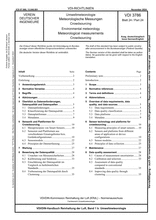Standards Worldwide
Standards Worldwide
Phone +49 30 58885700-07

Technical rule [CURRENT]
VDI 3786 Blatt 24:2024-11
Environmental meteorology - Meteorological measurements - Crowdsourcing
- German title
- Umweltmeteorologie - Meteorologische Messungen - Crowdsourcing
- Publication date
- 2024-11
- Original language
- German, English
- Pages
- 45
- Publication date
- 2024-11
- Original language
- German, English
- Pages
- 45
Product information on this site:
Quick delivery via download or delivery service
Buy securely with a credit card or pay upon receipt of invoice
All transactions are encrypted
Short description
Crowdsourcing, in the field of meteorological applications, refers to the collection of non-traditional weather observations from a large number of high-resolution sources, particularly from a range of public sensors typically available over the Internet. Advances in the miniaturization of transducers for meteorological parameters such as temperature, humidity, and pressure have resulted in the application of these sensors in inexpensive weather stations for home use and in many widely used electronic devices such as on-board computers in cars, smartphones, etc. This means that a wide range of measuring devices is available in principle for many applications, some of which can be accessed via the Internet. The standard shows possibilities how these sensors can be made usable for purposes of clean air, i.e. dispersion modeling and environmental monitoring as well as local climatological studies especially in urban areas. Meteorological input data are urgently needed for the calculation of the dispersion of air pollutants and for the evaluation of emergency situations. The same applies to local climatological investigations. For these applications there are available various VDI Standards (in particular the standard series VDI 3783, VDI 3785 and VDI 3787). This requires measurement data with high data quality. In this context, the standards of the World Meteorological Organization (WMO) are used as a basis, but they are adapted to the requirements of the mentioned questions with the standard series VDI 3786. The widespread availability of further data sources would significantly improve answering the questions of air pollution control and local climate assessment. For this, the data must be available in a quality (accuracy, maintenance, availability of metadata) that is sufficient for the questions. The mass availability of data and suitable mathematical data selection certainly open up new possibilities, which are shown in this standard. The standard also identifies opportunities for the use of appropriate transmitters, data processing, and quality assurance so that the networks that incorporate crowdsourced data can be used for purposes of clean air and local climate studies.
Content
ICS
07.060,
13.040.01
Also available in
Loading recommended items...
Loading recommended items...
Loading recommended items...
Loading recommended items...
